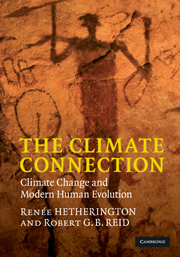Book contents
- Frontmatter
- Contents
- Foreword
- Preface
- Acknowledgements
- 1 Introduction
- Part I Early human history
- Part II Climate during the last glacial cycle
- Part III The interaction between climate and humans
- 7 The interaction between climate and humans
- 8 Climate and agriculture
- 9 Climate and our future
- Appendices: The biological background to the story of evolution
- References
- Index
- Plate section
7 - The interaction between climate and humans
Published online by Cambridge University Press: 05 August 2012
- Frontmatter
- Contents
- Foreword
- Preface
- Acknowledgements
- 1 Introduction
- Part I Early human history
- Part II Climate during the last glacial cycle
- Part III The interaction between climate and humans
- 7 The interaction between climate and humans
- 8 Climate and agriculture
- 9 Climate and our future
- Appendices: The biological background to the story of evolution
- References
- Index
- Plate section
Summary
Introduction
In the previous two chapters we reviewed Earth's changing climate and the impact of those changes on vegetation over the last 135,000 years. We know that over the last few million years Earth has experienced great climate variability. Massive glaciers have advanced and retreated in response to the Milankovic cycles and associated feedback cycles (Milankovic, 1998). In the early years, Milankovic cycles spanned 21,700 years, between 1 and 3 million years ago the dominant cycle shifted to 41,000 years, and over the last million years a 98,500-year cycle has prevailed. Yet during the last glacial cycle (the last 135,000 years), climate became more variable, even within the 98,500-year cycle. The amplitude of fluctuating temperature and rainfall increased (Richerson and Boyd, 2000). Climate oscillated within century and millennial cycles (GRIP, 1993). Low-latitude variations in temperature and rainfall (Broecker, 1996) and what were once centenary floods, droughts and windstorms, occurred more frequently, perhaps once a decade (Richerson and Boyd, 2000). Climate deterioration created a more patchwork global vegetation (Potts, 1996a, pp. 61–2). In contrast, the warm and relatively ice-free Holocene (the last 11,650 years) was a period of remarkable relative climate stability that allowed dominant species, particularly humans, to become more firmly established.
In this section of the text we draw attention to the interaction between climate and humans.
- Type
- Chapter
- Information
- The Climate ConnectionClimate Change and Modern Human Evolution, pp. 211 - 234Publisher: Cambridge University PressPrint publication year: 2010



